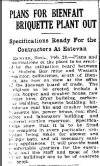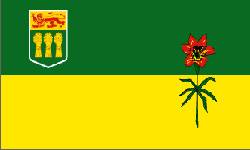|
As early as Oct 24, 1917,
Briquetting was thought of in the District.
Mr. W. J. Dick, M Sc., mining engineer from England,
wrote a report on Briquetting at Bienfait,
to the Commission of Conservation,
Carbonizing and Briquetting Plant
for treatment of Lignites in Saskatchewan.
Gas is produced as a by-product,
can be used for Brick Burning,
Power Plant or domestic heating.
The Federal government,
with the Manitoba, and Saskatchewan Governments,
established the Government Agency,
The Lignite Utilization Board.
They built an Experimental plant south of Bienfait,
between the Hudson Bay Mine,
and Western Dominion Collieries.

Feb 28, 1920,
plans are underway to build this plant.
July 8, 1920
Plant now expected to be in operation end of August 1920,
per a Mr. J. M. Leamy, Provincial Power Commissioner,
and member of the Lignite Utilization Board.
Expected output was 100 tons/day.
Operating at 90-100 days the first year.
The Foundations were being poured,
Contracts for Equipment were out,
Railway spur to the main CPR line
at Bienfait was nearing completion,
and expected cost was to be $12/ton for the Briquettes.
A Regina firm was constructing the buildings.

July 31, 1923
Problems arise in the operation of this plant
A Group known as the Lignite Utilization Board,
were the operators of the plant.

Sept 16, 1924
Hugh Sutherland tries to buy the plant
Wed- Jan 11, 1928,
almost 8 years after construction,
British Engineers, Balfour, Beatty & Co.
backed by the Industrial and General Trusts Co.
took over the Bienfait Char Plant,
and agreed to spend $500,000.
and to operate the plant for one year.
This plant was formerly dominated by Hugh Sutherland.
The plant was visited my Mr. Ernest Bury, MSc.
one of the best known Fuel engineers in the UK. in the summer of
1927.
He once worked for Brackley Coke works, in England,
and then was a Director for the Skinningrove Iron Co. Ltd, also in
England.
While teaching at the University of Mancester, in England,.
he wrote an article on by-Product of the Coking Practice.
They had tried unsuccessfully to get this plant running for many
years.
It appears with this mans help,
They were finally able to get it operating and producing briquettes,
from the formerly waste Lignite slack coal.
Before this the slack had to be removed from the mine,
and burnt on the open prairie,
due to the fact it was susceptible to spontaneous combustion.
Interesting to note, Balfour Beatty are celebrating 100 years in
operation in 2009.
The Plant was sold for a
Nominal sum
to a Company formed for the purpose,
Western Dominion Collieries,
which built a larger plant, and began production.
The Depression forced the
plant to close.
In 1937, A Mr. J. H. McDonald, from a Winnipeg firm,
Dominion Briquettes and Chemical Ltd.,
bought the plant from Western Dominion Collieries.
They began producing between 30,000-45,000 tons of Briquettes.
They produced for 20 years, until about 1958.
These were Furnace and fireplace Briquettes
called "Heat Glow"
1937 General Superintendents are
Harry W. Monahan,
and John Hamilton McDonald.
B. Lev a Saskatchewan man who lived near Estevan
a student of Iowa State College was the Company chemist.
Oil and gas were taking over the home heating duties,
So after much study,
and spending $500,000 on new Equipment,
they switched to making BBQ Briquettes,
and had the largest capacity on the continent.
March 1960 was the start of the new operation
and their first production run.
The brand names "Cook Out" and "Rodeo" were produced.
Their competition was Carbonized Wood Briquettes.
June 1961
John R. Hartwig, Plant Engineer. (see note 1 below)
General Manager J. Hugh McDonald (see below)
Plant Manager- A. Elberg. (misprint? should be Tony)
Manager of Research and Development, C. I. D. McDonald
The plant was in high gear in 1962.
Note 1- John R. Hartwig had 3 patents listed
dated Nov 1961, assignee, Husky Oil Co
under Wyoming Inventor, so assume he was an American.
By Mar 1963 the owner John Hamilton McDonald (jr)
was deceased.
May 1960 Julian "Hugh" McDonald is shown as
President and General Manager,
of Dominion Briquettes and Chemical Ltd.
He was the son of John Hamilton McDonald
and Marion Cecil McDonald, nee Drury. (see below)
It was a family owned company.
The McDonald family lived at 121 Park Boulevard
in Tuxedo area, of Winnipeg, from 1926 until 1964.
In 1926 he was an accountant in the firm of
Gooderham Melady and Sellers, later Federal Grain.
He later formed his own companies,
Dominion Briquettes and Chemical Company,
and McDonald Grain Company.
His property had a horse barn, tennis court, and ornamental gardens.
In 1963 the plant
superintendent was Tony Elberg
He spent 26 yrs at the plant and was transferred to Dickinson ND
John Hamilton McDonald (Jr)
b- Dec 15, 1883 in Listowel, ON
d- Mar 25, 1956 in Vancouver BC, age 72
married Marion Cecil Drury,
b- May 26, 1890 in Barrie ON
d- Apr 20, 1965 in Victoria, BC, age 74
daughter of Charles Alfred Drury, and Isabella Brownlee
father- John Hamilton McDonald (sr), b- ca
1852 in in Listowel, ON
shown as a Merchant in Cramahe ON
son of Alex McDonald and Mary McDonald
mother- Anna VanKleeck, b- ca 1855 in Thurlow, ON
married Sept 19, 1876 at Thurlow,
Hastings Co, ON
daughter of William VanKleeck and Julia Ann VanKleeck
John (Jr) and Marion had 5 children: Son-
Julian Hugh McDonald, BA, LLB
b- Sept 16, 1927 in Winnipeg MB
d- Apr 1, 2008, at St. Norbert Personal Care Home, Winnipeg MB, age
buried St. John's Cathedral, Winnipeg MB
He was a Businessman, Barrister and Company President.
President of Western Agriculture Supply Ltd.
President McDonald Grain Company Ltd.
President Texmac Resources.
Barrister in own company J. Hugh McDonald & Co.
Served in WWII.
Married Diane Mary Holden, Oct 1958,
b-?
d- 2000
daughter of Arthur E. Holden
son-
Ian McDonald
b-
d- bef 2008
married Janet McDonald, nee ?
daughter-
Marion McDonald
b-
d- bef 2008
married ? Daughter
Elizabeth McDonald
b-
d- living in 2008
married Mr. Armytage- Winnipeg
Daughter
Cynthia McDonald
b-
d- living in 2008
married Andrew Hunter- London ON
|

